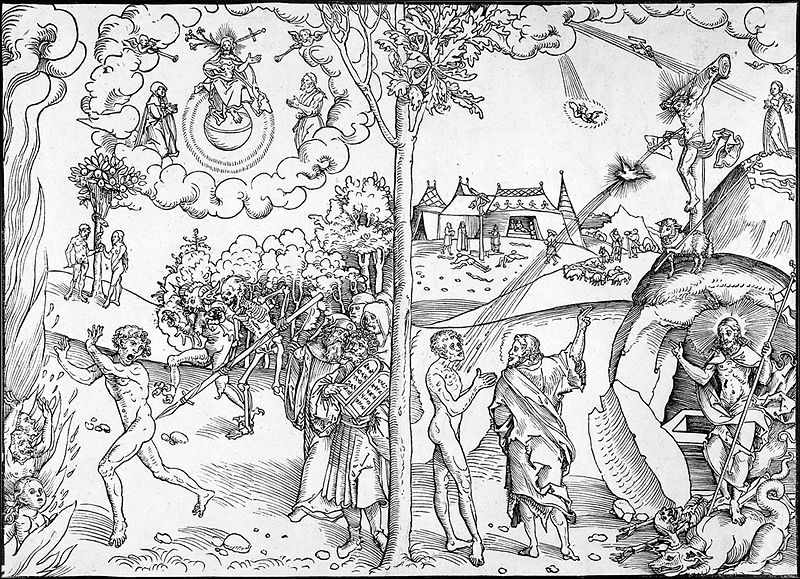Lucas Cranach the Elder. c. 1530 C.E.Germany. Woodcut and letterpress
Allegory of Law and Grace
Year: 1529
Context:
Destruction of thousands of works of religious art
Iconoclasts stormed through churches
“How did heaven get to be so controversial?”
Form
Material/technique → woodcut and letterpress
Lucas Cranach the Elder = artist
Located in Germany
Media = oil on wood
Northern Renaissance
72 cm by 88.5 cm
Lucas Cranach the Elder
Influential artists in 16th century German art
Printmaker and painter
Representative of the Northern Renaissance
His father, Hans Maler, was a painter and gave Cranach his first lessons
He adopted the name Cranach when he was 30 years old
Birth place = now Kronach
As court painter of the Elector of Saxony, the patron of Luther, he is remembered as the chief artist of the Reformation
Moved to Vienna in 1501
Full of expression and dynamic
Moved to Wittenberg in 1505
More static style
Met the reformed Martin Luther = portrayed in his works
He also sold medicine, papers, ran a wine pub, printed books
He was elected as mayor three times
A talent for politics
1524–met Albrecht Durer
Lutheran Reformation
The Law and the Grace
Single most influential image of the Lutheran Reformation
The Reformation––initiated by Martin Luther in 1517 (attempt to reform the Catholic Church, which had been the only church in western Europe up until Luther)
The Role of Art
The Law and the Grace explains luther’s ideas in visual form
Heaven is reached through faith and god’s grace
Luther despised and rejected the Catholic idea that good deeds (“good works”) could play any role in salvation
Catholics Vs. Luther: how to get to heaven?
Catholics
Believer could take action to vouchsafe their salvation by good deed (financial donations and paying for art)
Luther
Insisted that salvation was in God’s hands and all the believer had to do was to open up and have faith
Anger led to rebellion and destruction of artwork that the Catholic Church was become rich on
Scene:
Two nude figures appear on either side of a tree that bisects the composition
Law (left) = dying tree
Gospel (right) = living tree
Tree is dead on the side of the Law but vibrant on the side of the Gospel
The altarpiece from left to right
Six columns of Bible citations appear at the bottom of the panel
Left (Law) Side
Scene:
Law and judgement symbolized by a man being forced into hell by Death (skeleton) and Satan (demon)
Moses delivers the Ten Commandments
Moses beholds these events; his white tablets standing out against the saturated orange rope and green tree
Highlighting the association of law, death, and damnation
Held by a figure that appears to be Luther himself (Cranach consistently depicted Luther in his portraits alongside biblical figures)
Christ sits in judgement
Adam and Eve partake in eating the forbidden fruit
Motifs (left) are meant to exemplify the idea that law alone, without gospel, can never get you to heaven
Right (Gospel) Side
Scene:
Grace and Gospel with Christ’s cross crushing Death and Satan
Blood of christ covers those near the cross
John the baptist directs a naked man to both Christ on the cross in front of the tomb AND to the risen Christ who appears on top of the tomb
Risen Christ = stands triumphant above the empty tomb, acting out the miracle of the Resurrection
Nude figure is not hoping to follow the law on judgement day
Stands passively, stripped down to his soul, submitting to God’s mercy
Lutheran saw the law as the side in which financial donations enriched the church and should not be a way to salvation; in the gospel side he believed through your own belief in god should be enough to bring his grace
Law paves the way to salvation by preparing the way for grace
God judges and God shows mercy
The Law and the Grace is concerned with two roles that God plays:
Judge (condemns human sin)
Show mercy (forgiveness)
Granting unearned salvation to sinful believers
Luther's idea of law is multifaceted and complex relationship to his idea of gospel
Law alone will never make salvation possible, law paves the way to salvation
Includes events from both the New and Old Testament
Concerns two aspects of the relationship between humanity and god
Describes events throughout the bible which reveal the dual aspect of god’s relationship to people
Cranach's pictorial translation of Luther’s unique understanding of salvation
Interprets the roles of law, good works, faith, and grace in the human relationship to God
Themes
Personal faith
Protestantism
Allegories
Christianity
Cross Cultural Connections
Catacomb of Priscilla
Arena Chapel (Lamentation)
Lukada (memory board)
Last judgement of Hu-Nefer, Book of the Dead
Pictures:








